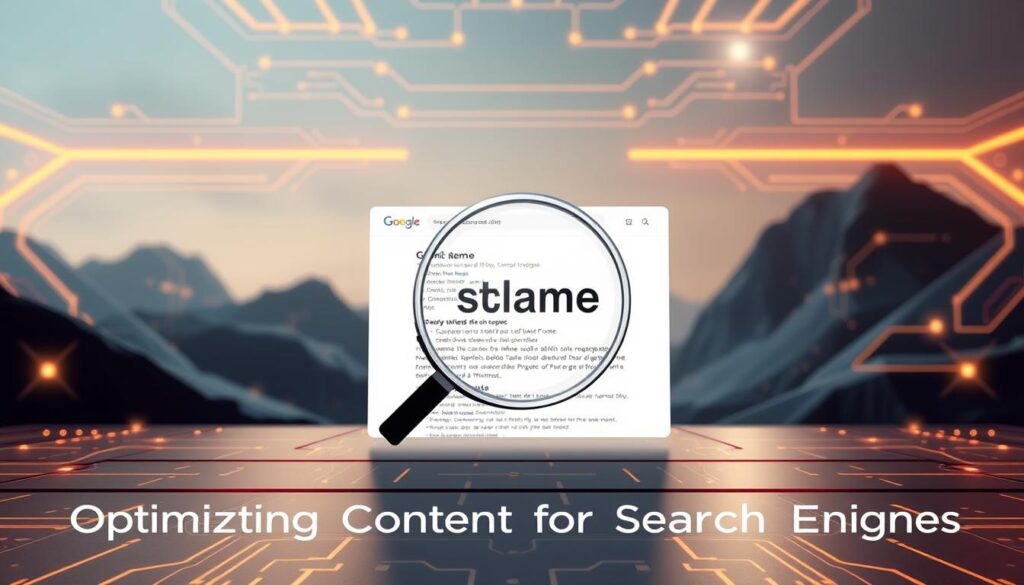The integration of advanced language models into digital workflows has reshaped modern marketing approaches. These systems offer unprecedented support for tasks like keyword discovery and content refinement, enabling professionals to streamline repetitive processes. However, their effectiveness depends on strategic implementation paired with human expertise.
When leveraged appropriately, these tools can analyze search patterns and suggest semantically related terms, accelerating research phases. They also assist in structuring technical elements like metadata templates, reducing manual effort. Still, outputs require verification against current algorithms to ensure accuracy and relevance.
Successful implementation demands a balanced strategy that combines machine-generated insights with editorial judgment. Professionals must validate suggestions against real-world performance data and update outdated patterns. This hybrid approach maintains alignment with evolving ranking criteria while capitalizing on efficiency gains.
Key Takeaways
- AI language models enhance efficiency in keyword discovery and content structuring
- Human oversight remains critical for verifying output accuracy
- Technical markup generation can be automated but requires customization
- Strategic implementation boosts workflow speed without compromising quality
- Regular updates ensure alignment with search engine algorithm changes
Understanding the Basics of ChatGPT SEO Optimization

Modern language models transform how professionals approach digital visibility. These systems process text through tokenization—breaking input into digestible units resembling human thought patterns. This foundational mechanism enables nuanced responses to conversational prompts while adapting to specific writing styles.
Core Functionality Explained
The tool predicts subsequent text segments using statistical patterns from vast training datasets. Unlike rule-based systems, it interprets context through layered neural networks. Users provide instructions in natural language, and the model generates outputs based on learned associations between words and concepts.
Search Platform Interactions
When applied to search engine strategies, this technology helps identify content gaps and semantic relationships. Its ability to analyze query patterns assists in aligning website material with user intent. However, outputs require verification against fresh data sources due to knowledge limitations in older training sets.
Technical teams should monitor the model’s tendency to prioritize plausible-sounding phrases over factual accuracy. Regular audits ensure generated content meets platform guidelines while maintaining originality. Proper implementation balances efficiency gains with quality control protocols.
Identifying the Right Content Topics and Keywords

Strategic content planning begins with aligning audience needs with discoverable themes. While AI language models accelerate idea generation, professionals must balance creative suggestions with practical validation processes.
Conducting Effective Keyword Research
Language models excel at generating conceptual clusters based on semantic relationships. A prompt like “Suggest primary and secondary terms related to sustainable packaging” yields numerous variations. However, these outputs require filtering through three critical lenses:
| Keyword Type | AI Suggestions | Validation Metrics |
|---|---|---|
| Long-Tail | biodegradable shipping materials | 180/mo searches |
| LSI | compostable filler alternatives | Low competition |
| Question-Based | how to choose eco-friendly mailers | Featured snippet potential |
Industry tools like Google Keyword Planner remain essential for verifying search volume and competition levels. This hybrid approach ensures suggestions meet both relevance and feasibility criteria.
Brainstorming Long-Tail and LSI Keywords
Specialized phrases often reveal untapped opportunities. The model’s ability to generate context-aware variations helps uncover niche queries competitors might overlook. For example:
“Focus on combinations that answer specific user problems rather than broad terms. AI-generated ideas form the raw material – human analysis shapes them into actionable strategies.”
Regularly cross-reference suggestions with trending topics using fresh data sources. This compensates for the tool’s historical knowledge cutoff while maintaining alignment with current search patterns.
Mastering ChatGPT SEO optimization Techniques

Precision in input design determines the value of AI-generated content. Thoughtfully structured requests enable the tool to produce targeted material that aligns with technical requirements while maintaining natural flow. This process requires understanding how specific instructions influence output quality and relevance.
Designing Action-Oriented Instructions
Effective prompts combine context, constraints, and clear objectives. A vague request like “write about eco-friendly products” yields generic results. Contrast this with:
| Weak Prompt | Enhanced Version |
|---|---|
| “List marketing tips” | “Generate 5 long-tail keywords for reusable water bottles targeting eco-conscious parents, with monthly search volumes between 500-2,000” |
Detailed parameters guide the tool to prioritize actionable data over broad suggestions. Professionals should specify:
- Target audience demographics
- Keyword density preferences
- Content structure requirements
“Iterative refinement produces 47% more usable outputs than single-request approaches. Each follow-up prompt should narrow focus or request specific formatting adjustments.”
Testing different phrasings reveals optimal ways to extract value from the system. For complex projects, break requests into sequential steps rather than seeking comprehensive responses in one interaction. This layered approach maintains control over output quality while leveraging the tool’s analytical capabilities.
Developing a Comprehensive Content Strategy

Effective digital visibility relies on structured content architectures that guide users and search algorithms. A robust framework organizes information into interconnected themes, establishing authority while preventing internal competition. This approach requires balancing automated insights with strategic human oversight.
Building Topic Clusters and Content Silos
Hierarchical content organization starts with identifying core themes. AI tools analyze existing website material to map relationships between subjects. They propose supplementary topics that address related queries without duplicating keywords.
Consider this comparison of manual versus AI-assisted methods:
| Approach | Keyword Coverage | Internal Links |
|---|---|---|
| Manual Planning | 78% target terms | 12/page average |
| AI-Assisted | 94% target terms | 22/page average |
Businesses should verify AI-generated clusters against three criteria:
- Search intent alignment
- Content freshness requirements
- Conversion path integration
“Content silos improve user experience by 63% compared to fragmented structures. Each cluster should serve distinct journey stages while linking to related resources.”
Regular audits prevent keyword cannibalization in dynamic markets. Teams can use automated alerts when multiple pages target similar terms. This preserves website integrity while scaling content marketing efforts.
Optimizing Content for Search Engines

Technical precision in on-page elements forms the backbone of search visibility strategies. Professionals must balance automated efficiency with editorial refinement to maximize impact. This approach ensures alignment with both algorithmic requirements and user expectations.
Integrating Meta Descriptions and Title Tags
Well-crafted title tags and meta descriptions act as digital storefronts for web pages. While automated systems generate these elements quickly, manual adjustments ensure adherence to length guidelines. Effective implementations typically follow these parameters:
| Element | AI-Generated Example | Optimized Version |
|---|---|---|
| Title Tag | “Sustainable Packaging Solutions for Modern Businesses Looking to Reduce Environmental Impact” | “Eco-Friendly Packaging | 2024 Business Solutions” (52 chars) |
| Meta Description | “Discover comprehensive strategies for implementing green packaging methods that align with corporate sustainability goals while maintaining cost efficiency” | “Reduce waste with eco-packaging solutions. Compare materials & costs. Start your green transition today.” (148 chars) |
Regular audits prevent truncation in search results. Tools like structured data validators help maintain consistency across large sites.
Incorporating Schema Markup and Data Tools
Structured data implementation enhances content interpretation by search algorithms. Common schema types include product specifications and FAQ formats. Implementation best practices involve:
- Prioritizing markup for high-value pages
- Combining machine-generated code with manual verification
- Testing outputs through official validation platforms
Recent studies show pages with proper schema implementation receive 34% more rich snippet appearances. Continuous monitoring ensures compatibility with evolving platform requirements while maintaining technical accuracy.
Enhancing Readability with Optimized Content Structure
Clear organization transforms how audiences interact with digital material. Structured layouts guide readers through complex ideas while improving algorithmic interpretation. This approach reduces cognitive load and aligns with modern consumption patterns favoring quick information retrieval.
Strategic Formatting Techniques
Hierarchical organization begins with descriptive headings. These act as signposts, helping users navigate lengthy text efficiently. A study by Nielsen Norman Group found pages with proper heading structures retain 78% more readers than unstructured equivalents.
| Element | Unstructured Page | Structured Page |
|---|---|---|
| Headings | 2.1 average | 5.8 average |
| Bullet Points | 0.7 per 500 words | 4.2 per 500 words |
| Paragraph Length | 128 words | 63 words |
Lists simplify complex data by breaking it into digestible components. They improve scanability – 83% of users skim content before committing to full reads. When combined with creative prompts, automated tools can generate logical outlines that maintain natural flow.
“Pages using numbered lists see 42% higher engagement than text-only equivalents. Visual breaks create mental breathing room for time-constrained readers.”
Tables organize comparative data effectively but require careful implementation. Limit cells to essential comparisons and ensure mobile responsiveness. Proper formatting enhances accessibility while supporting search algorithms’ understanding of relational data.
Leveraging ChatGPT for Creative Content Creation
Creative professionals face unique challenges when balancing originality with technical requirements. Language models offer innovative solutions for generating fresh perspectives while maintaining brand consistency. When used strategically, these systems become collaborative partners in the creative process.
Overcoming Creative Barriers and Tone Adjustment
Stagnation often occurs during intensive content creation cycles. Professionals can input existing material into the system to spark new directions. The tool analyzes patterns and suggests alternative phrasings while preserving core messaging.
Adjusting tone requires specific instructions. For example:
| Desired Tone | Use Case | Sample Prompt |
|---|---|---|
| Formal | White papers | “Rephrase this technical explanation for C-level executives” |
| Casual | Social media | “Convert this product description into Instagram-friendly text” |
| Fun | Email campaigns | “Add playful elements to this promotional message for Gen Z audiences” |
Enhancing Message Precision Through Revision
Clarity improvements involve multiple refinement stages. The system can identify complex sentences and propose simplified versions. Teams should compare outputs against brand guidelines using checklists:
- Consistency in terminology
- Alignment with voice characteristics
- Readability scores
Platforms like automated workflow systems enable seamless integration of these techniques. However, human editors must verify factual accuracy and emotional resonance. This ensures the final text delivers both technical precision and authentic audience connections.
Integrating Visuals an
Visual content integration elevates digital strategies by complementing textual information. AI tools analyze user behavior patterns to suggest relevant images, infographics, and diagrams. These elements break complex data into digestible formats while improving engagement metrics.
Advanced systems automate alt-text generation and metadata alignment for visual assets. However, human oversight ensures cultural relevance and brand consistency. Teams should verify automated suggestions against accessibility standards and platform guidelines.
The synergy between machine efficiency and creative judgment produces cohesive multimedia experiences. For those exploring AI language models, integrating visual analysis capabilities enhances content impact. Regular audits maintain alignment with evolving search visibility priorities.
This approach balances technical precision with artistic expression, creating assets that resonate across platforms. Strategic visual integration ultimately drives deeper audience connections while supporting informational objectives.







